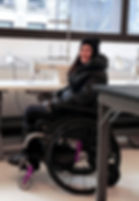Project Integrate is a seven design collection created in collaboration with AARP and Open Style Lab to seamlessly accommodate women of diverse bodies and backgrounds through garment adjustability. This closureless line allows people with limited grip capabilities a simple and stylish alternative when getting dressed. It also features thermochromic prints that act as a temperature indicator for the paralyzed or nonverbal. The prints change color when they come in contact with high temperatures.
The focus of Project Integrate is not to put a spotlight on inclusive design and create garments specifically for the disabled; rather, it is a showcase of my personal design aesthetic created in a universally accessible way, so that a broader audience is able to wear and appreciate it. From the past to the present, clothes have become easier and easier to don and doff. Take, for example, Victorian-era corsets, petticoats, and boots. The multitude of buttons alone made it difficult for even non-handicapped persons to wear. While there has since been an increase in disability awareness and design, I believe there is still more to improve in terms of bulk and aesthetic in order to fully incorporate accessible design in everyday clothing.



Meet my mentors: Tonya Capers, Christina Mallon, and Madeline DeAddio. Tonya is a 42-year-old New York based graphic designer with Transverse Myelitis (TM). TM is a condition that causes inflammation of the tissue surrounding nerve cell fibers in the spine, called myelin. For Tonya, this caused paralysis from the waist below. Due to the limited sensation in her legs, she inspired my design for thermochromic prints as a temperature indicating system. Madeline DeAddio currently mentors newly injured spinal cord patients, advocates for the disabled community, and often engages in adaptive sports alongside Tonya. She has a C5-C6 incomplete spinal cord injury from the age of 23 that caused paraplegia - paralysis and limited grip capabilities, which inspired the closureless feature of my design. While she is able to put on and take off jackets and such with ease, she is unable to button her clothes and has trouble with open zippers closures. Christina Mallon is currently the head of Inclusive Design and Accessibility at Wunderman Thompson Global and is a partner and board Member of OSL. She was diagnosed with Amyotrophic lateral sclerosis (ALS) at the age of 22, which left both of her arms paralyzed. She and Madeline inspired my closureless wrap design due to their low dexterity.
To create my perfect color-changing print, I experimented with a multitude of fabric paints and thermochromic inks. These prints are designed to change color when they come in contact with temperatures over 50C/122F. This is just above a normal body temperature of 37C/98F, but lower than the industry standard temperature minimum that insulation must be applied in case of accidental contact, 60C/140F. However, the activation temperatures of thermochromic inks are tricky and often limited in color commercially. Most thermochromics available for purchase have the activation temperature of 36C, around normal body temperature, in order to create visible changes more prevalently. In my test swatches, I printed a layer of the image in a red fabric paint before adding a thermochromic layer. The black polyester also required a white base layer for the red to show.
This project was sponsored in part by Microlite Industrial Co., Green Energy Nanotechnology, and ISKO Denim. Microlite Industrial Co. manufactures a retro-reflective particle coated knit fabric that has a holographic effect on the surface. Polyurethane is used to coat the knit polyester textile that has some stretch, is abrasion- and water-resistant, and can be cut and sewn like a regular coated textile. Green Energy Nanotechnology provided PET fiber fabrics infused with a (10-µm for human safety) precious metal complex of high purity germanium, titanium, and pi elements that are then blended with different natural and synthetic fibers to offer comfort and long-lasting, wash-proof performance. ISKO Denim's double-textured fine denim fabric was developed to enhance softness and thermal insulation. This double-textured hybrid denim is made with fibers twice as fine as silk and three times finer than cashmere. It is typically composed of 76% cotton (CO), 17% polyester (PES), 6% PA, and 1% elastane (EA). the fabric is woven as a double-faced fabric in one step. Lastly, my designs require baby diaper velcro that provides comfort and flexibility within my garments.

















